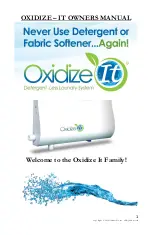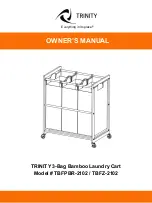
18
Table of contents
Instruction manual
Important safety information
18
Causes of damage
19
Environmental protection
20
Environmentally-friendly disposal
20
Getting to know the appliance
20
How does a vacuuming drawer work?
20
Structure of the vacuuming drawer
20
Control panel
21
Opening and closing
21
Accessory
21
Switch the appliance on and off
22
Vacuuming in the bag
22
Suitable vacuuming bag
22
Proceed as follows:
23
Heat-sealing in good time
23
Cancelling the vacuuming process
23
Vacuuming in the container
24
Suitable vacuuming containers
24
Cancelling the vacuuming process
24
Carrying out the drying program for vacuum
pump
25
Applications
25
Vacuum for sous-vide cooking
25
Vacuum-sealing glass bottles
26
Fast marinating and flavouring
26
Storage and transport
26
Recommended settings
27
Care and cleaning
28
What to do in the event of a fault
29
After
sales service
31
Additional information on products, accessories,
replacement parts and services can be found at
www.gaggenau.com
and in the online shop
www.gaggenau.com/zz/store
m
Important safety
information
Read these instructions carefully. Only then will
you be able to operate your appliance safely and
correctly. Retain the instruction manual and
installation instructions for future use or for
subsequent owners.
Check the appliance for damage after
unpacking it. Do not connect the appliance if it
has been damaged in transport.
This appliance is intended for domestic use and
the household environment only. Only use the
appliance to vacuum food in suitable vacuuming
bags and vacuuming containers, and to heat-
seal film.
Only operate this appliance in enclosed rooms.
This appliance may be used by children over the
age of 8 years old and by persons with reduced
physical, sensory or mental capabilities or by
persons with a lack of experience or knowledge
if they are supervised or are instructed by a
person responsible for their safety how to use
the appliance safely and have understood the
associated hazards.
Children must not play with, on, or around the
appliance. Children must not clean the
appliance or carry out general maintenance
unless they are at least 15 years old and are
being supervised.
Keep children below the age of 8 years old at a
safe distance from the appliance and power
cable.
This appliance is intended for use up to a
maximum height of 4000 metres above sea level.
Risk of burns!
The sealing bar in the vacuuming chamber
becomes extremely hot if the appliance is used
frequently and there are long heat-sealing times.
Never touch the hot sealing bar. Keep children
away from the appliance.
19
Risk of electric shock!
▯
Do not use any high-pressure cleaners or
steam cleaners, which can result in an
electric shock.
Risk of electric shock!
▯
A defective appliance may cause electric
shock. Never switch on a defective
appliance. Unplug the appliance from the
mains or switch off the circuit breaker in the
fuse box. Contact the after-sales service.
Risk of electric shock!
▯
Incorrect repairs are dangerous. Repairs
may only be carried out by one of our trained
after-sales engineers. If the appliance is
faulty, unplug the mains plug or switch off
the fuse in the fuse box. Contact the after-
sales service.
Risk of fire!
The sealing bar in the vacuuming chamber
becomes extremely hot. Combustible vapours
may ignite. Do not vacuum any combustible
liquids in the vacuuming bag. Do not store any
combustible materials and objects inside the
appliance.
Risk of injury!
▯
The smallest cracks in the glass lid may
result in it imploding when the vacuum is
attached. Unplug the appliance from the
mains or switch off the circuit breaker in the
fuse box. Call the after-sales service.
Risk of injury!
▯
During the vacuuming process, the
vacuuming chamber and the glass lid
deform. Screw-top jars, other hard
containers, and indeformable food that are
vacuumed in the compartment when the lid
is closed must not come into contact with
this lid. Otherwise, the protective layer on
the glass will be damaged and the glass lid
may break. Hard containers and
indeformable food must not protrude over a
maximum height of 80 mm.
Risk of injury!
▯
Any misuse of the vacuuming drawer may
lead to injury. Do not insert any hoses that
are connected to the appliance into any
body cavities. Do not vacuum any living
animals.
Causes of damage
Caution!
–
Check the appliance for damage before each use.
Pay particular attention to the intactness of the
glass lid.
Do not operate the appliance if the glass lid is
damaged. Call the after-sales service.
–
Slowly open and close the glass lid.
–
Do not place any objects on the glass lid. Do not
use the appliance as a work surface or storage
space. Ensure that no objects can fall onto the
glass lid. To use it, pull the drawer out fully until it
reaches a stop. Completely close the drawer if you
are not using it.
–
Before closing the glass lid, ensure that there is no
debris in the vacuuming chamber.
–
Ensure that the seals are not damaged by pointed
or sharp objects.
–
Check that the seal on the glass lid is positioned
correctly. Ensure that the seal's contact surface is
clean and free from debris. Otherwise, this may
impair the functionality of the appliance.
Do not operate the appliance if the seal is
defective. If you do so, this may damage the
appliance. Call the after-sales service.
–
Observe the cleaning instructions.
–
In the event of a power failure, the vacuum remains
in the vacuuming chamber during the vacuuming
process. Never attempt to use a tool to open the
glass lid. Wait until the power supply has been re-
established and restart the vacuuming process
–
Do not vacuum food in its original packaging after
you have opened it. Only use bags that are suitable
for vacuuming food.
–
In the vacuum, liquids start to boil at low
temperatures. This produces vapour and may cause
the appliance to malfunction.
‒ Ensure that the food to be vacuumed is at the
lowest possible initial temperature – within the
range of 1 – 8 °C is best.
‒ Never vacuum liquids in the vacuuming bag at
the maximum vacuuming level.
‒ Recommendation: Vacuum liquids in the
vacuuming bag at vacuuming level 2.
‒ Carefully monitor the vacuuming process. It is
normal for some bubbles to form when
vacuuming liquids. Heat-seal the bag in good
time as soon as the bubble formation visibly
increases.
‒ Tip: You can also vacuum liquids in fixed,
commercially available vacuuming containers.
Use vacuuming level 3 for this. When
vacuuming, do not use any plastic bottles or
other vessels that contract during external
vacuuming.














































